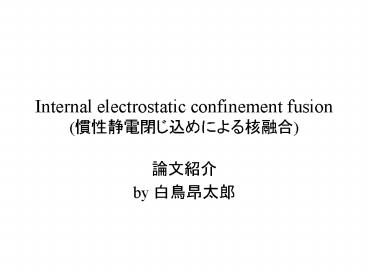Internal electrostatic confinement fusion (??????????????) - PowerPoint PPT Presentation
1 / 22
Title:
Internal electrostatic confinement fusion (??????????????)
Description:
Institute of Advanced Energy, Kyoto University. Prof. Kiyoshi Yoshikawa's Research Group ... Glow discharge Magnetron ion source ... – PowerPoint PPT presentation
Number of Views:113
Avg rating:3.0/5.0
Title: Internal electrostatic confinement fusion (??????????????)
1
Internal electrostatic confinement
fusion(??????????????)
- ????
- by ?????
2
Paper
3
Institute
- Institute of Advanced Energy, Kyoto University
Prof. Kiyoshi Yoshikawa's Research Group - ??????????????? ??????????? ??????????? ?? ?
??? - http//www.iae.kyoto-u.ac.jp/beam/index_j.html
4
Brief introduction of Internal electrostatic
confinement fusion IECF
- IECF is the scheme of injecting the ions and
electrons towards the spherical center, trapping
both species in the electrostatic self-field and
giving rise to fusion in the dense core. - (Fusion mechanism is not completely understood.)
- For effective production of neutron, multi-well
potential is needed. - Energy of neutron
- dd?3Hen 2.5 MeV
- dt?4Hen 14.1 MeV
- (d3He?4Hep 14.7 MeV)
5
Background
- The concept of IECF is conceived in 1950s.
- The first purpose is to investigate the room
temperature fusion system (for power source ?). - ?Not realistic
- ?Latest type, input 100W ?Output by fusion 1µW
- But
- IECF is a good neutron source.
- ? Investigation is continued.
6
The Machine
Intensity of neutron dd?3Hen 2.5 MeV ? 5106
n/s (High voltage and ion current are unknown)
7
Advantage of IECF compared with neutron source
(example 252Cf)
- Mono-energetic spectrum
- No decreasing by particle decay
- Easy to operate
- Able to use proton source
- (d3He?4Hep 14.7 MeV)
- Good application ?
Energy spectrum of neutron from 252Cf O.I.
Batenkov et al., INDC(NDS)-146,(1983)
8
Purpose of this paper
- To measure ion current dependency of neutron
yield (N?I2) for investigating IEFC mechanism - To explain mechanism by theoretical calculation
for offering the technical advantages - ?
- The structure of internal potential is unknown. ?
fusion mechanism - Information for developing the technical progress
To optimize high voltage, current and to
develop cooling system ?Technical advantages
9
Ion current dependency of neutron yield
- Calculation by multi-well potential N?I2 (Iion
current) - ?Experimental result scales linearly I
- Limitation of high voltage and current are 70kV
and 15 mA, respectively. - Not to exceed the threshold for multi-well
potential - Perveance I(mA)/V1.5(kV) gt 2.2
- Re-experiment by sufficient condition by using
pulse current - I2 dependency over the threshold was confirmed.
10
Result of theoretical calculation
- To construct the program by multi-well potential
and to simulate the dependency of ion current - N?I3 dependency exists in the high current
region. - ?Increased ion current make multi-well potential
unstable and this unstably increase the density
of central region. - ?The experiment to confirm this dependency in the
high current region should be performed.
11
Result of theoretical calculation
- To construct the program by multi-well potential
and to simulate the dependency of ion current - N?I3 dependency exists in the high current
region. - ?Increased ion current make multi-well potential
unstable and this unstably increase the density
of central region. - ?The experiment to confirm this dependency in the
high current region should be performed.
12
Conclusion
- The dependency of ion current (N?I2) by
multi-well potential is confirmed. - There may be the dependency N?I3 in the high ion
current region. - ? The experiment should be performed.
13
Progress after this experiment
- Multi-well potential was first measured by the
laser-induced fluorescence method. - To increase the nuetron intensity of D-D reaction
- ? 2108 n/s
14
Future plan
- Improvement of ion source
- Glow discharge Magnetron ion source
- Intensity of neutron will be increased by
one-order (108?109 n/s).
15
Application
16
Examples
17
Mine sweeper ?
- Development with 7 organizations
- They plan to operate this machine in Afghanistan.
18
Why neutron source ?
- It is very difficult to distinguish mine from
other metals by metal detector. - ? mine/metals 1/1000 under the ground
- ?The plastic and ceramic mine cannot be detected.
- The composition of TNT is known.
- ?By measuring ? ray from TNT reacted with neutron
and back scattered neutron by proton in TNT, we
will be able to distinguish mine from other
metals.
19
What detect ?
- ? ray from neutron capture 1H(n,?), 14N(n,?)
- Energy
- 1H(n,?) 2.22 MeV
- 14N(n,?) 10.8 MeV
- CsI, NaI, BGO for detection
- 10.8 MeV ? Detected by BGO multi compton gamma
camera
20
BGO gamma compton camera
- Expected performance
- (1m1m field, 20cm depth, 30 g mine)
- 106 n/cm2/s
- Efficiency 99.9
- Miss identify 40 _at_ 10 min
21
Other method
????????????????? ???????????
22
Summary
- Present performance of IECF 2108 n/s.
- IECF will be able to be used for several
applications by adjusting neutron intensity. - Mine sweeper with IECF is planned.































